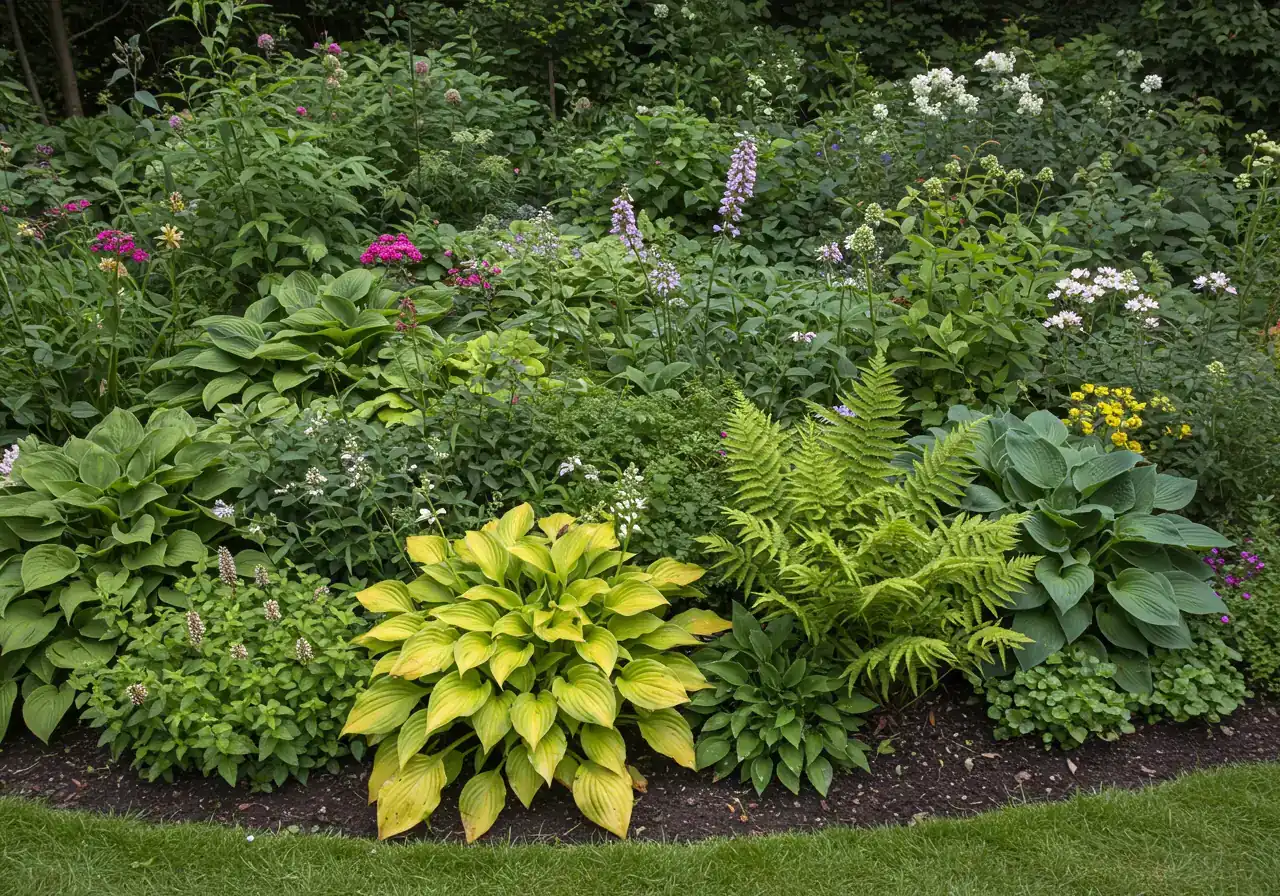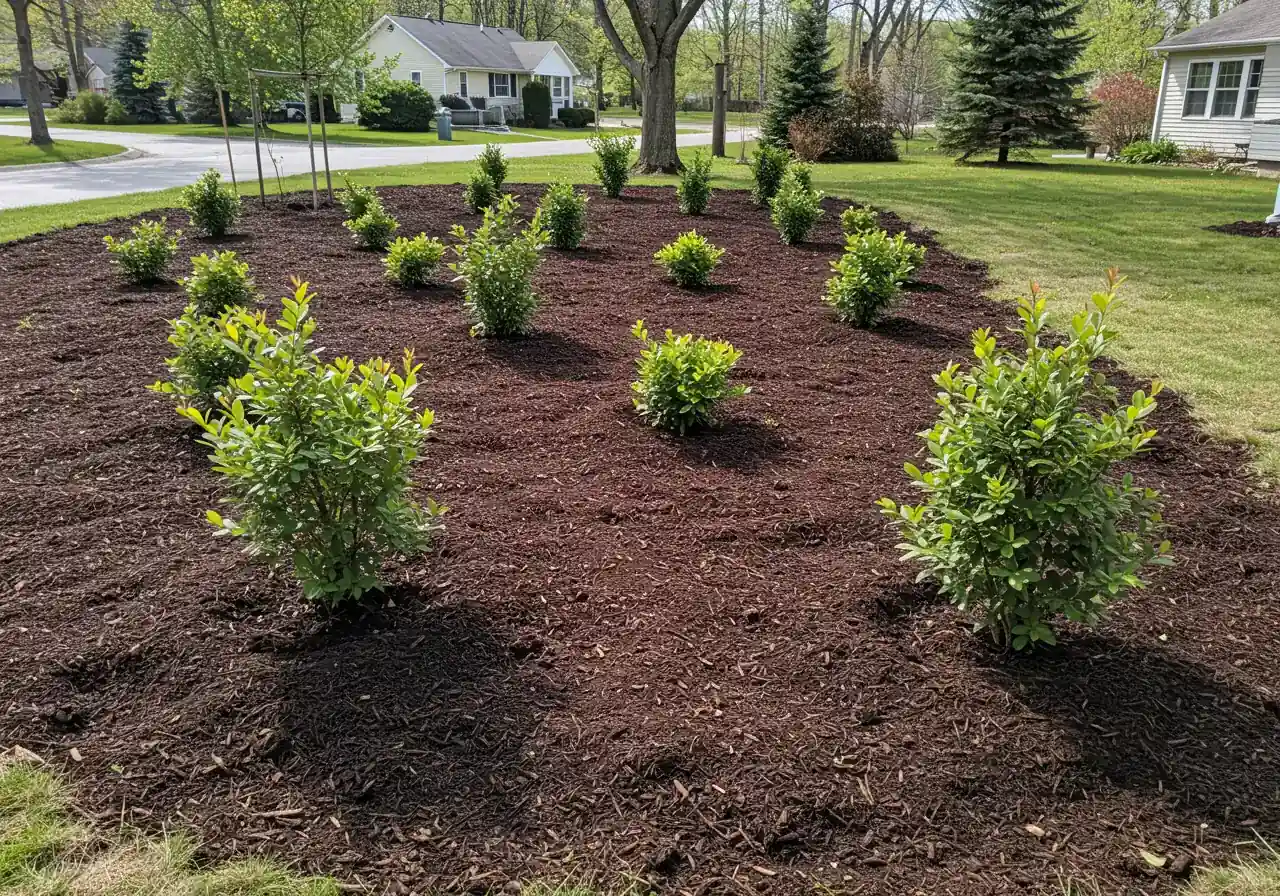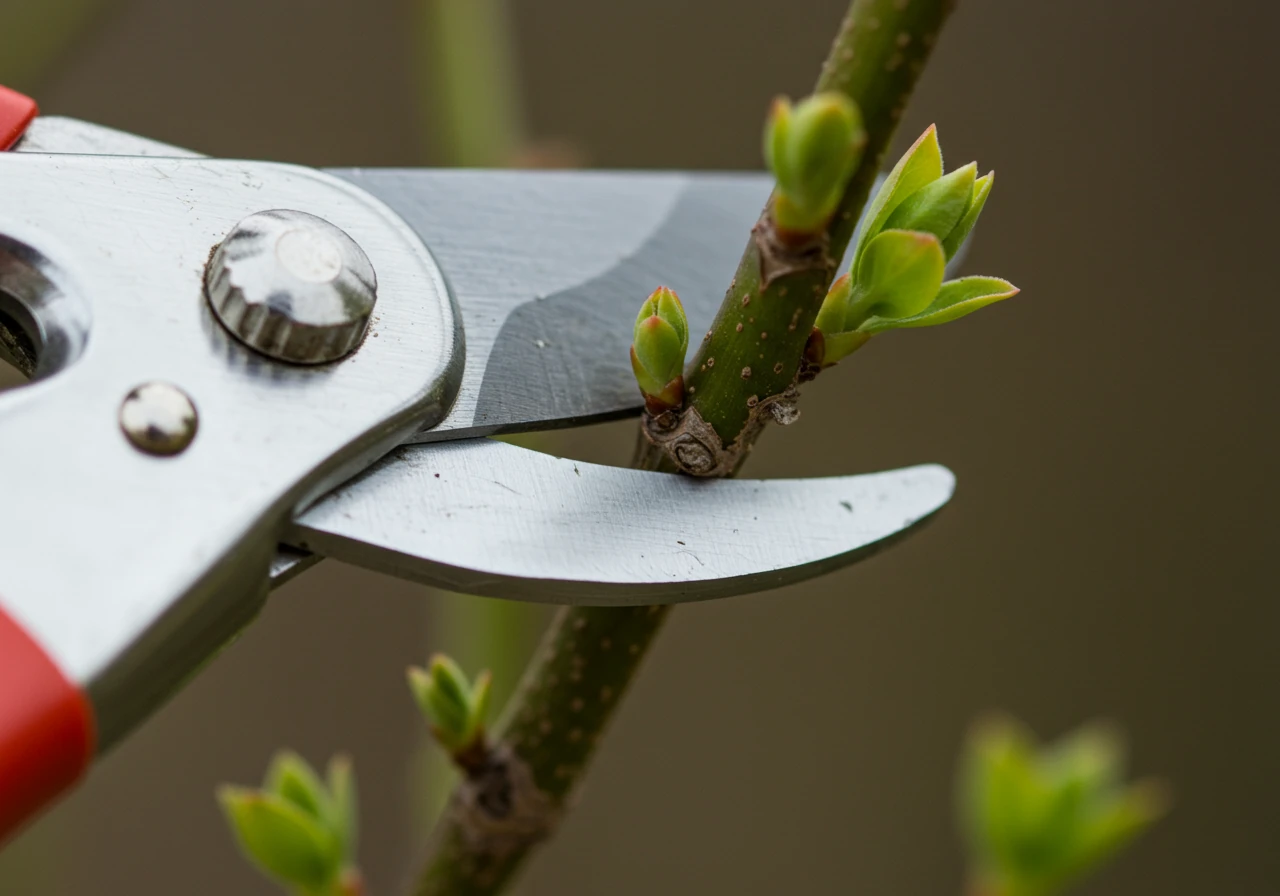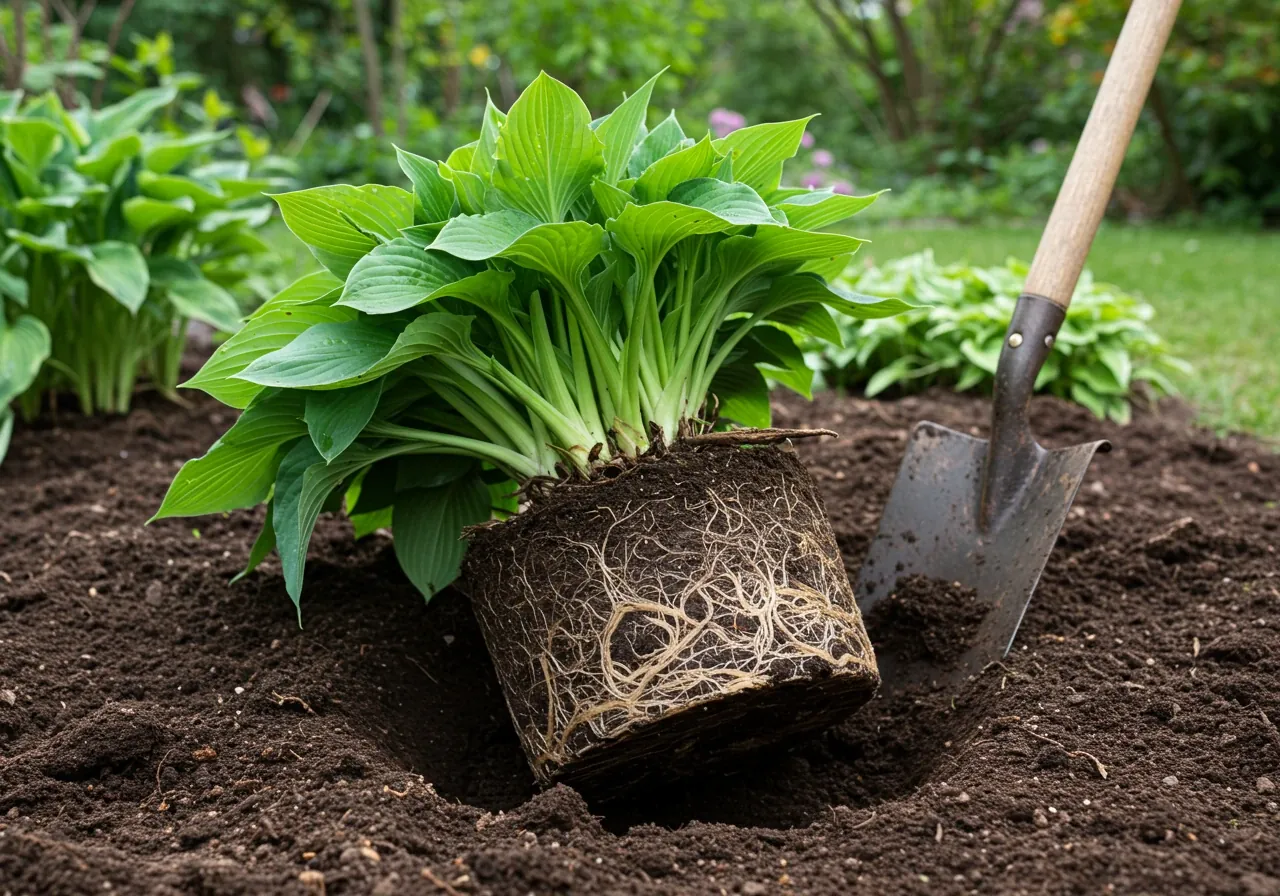Nepean Garden Growth Control: Prevent Summer Overcrowding
Is your garden getting out of hand this summer? Get expert help to keep it beautiful and manageable. Request a free quote today!
Quick Tips for Garden Growth Control:
- Check mature plant sizes *before* planting to ensure proper spacing.
- Prune regularly to maintain shape, health, and airflow. Time pruning based on blooming season.
- Divide overgrown perennials in spring or fall to rejuvenate them and gain free plants.
- Use barriers or containers for aggressively spreading plants.
- Improve soil health for balanced, predictable growth.
- Don't hesitate to call professionals for major cleanups or complex tasks.
Introduction: Taming the Wild! Keeping Your Nepean Garden Gorgeous, Not Overgrown
Welcome, fellow Nepean green thumbs! Ever feel like your lovely spring garden suddenly throws a wild party in July and forgets to clean up? You blink, and suddenly your carefully planned flower beds look more like a botanical free-for-all. It’s a common sight across Ottawa, from Nepean right over to Barrhaven. Our short growing season means plants make the *most* of the summer sun, sometimes a little *too* much! That speedy growth can quickly turn a charming space into an overgrown tangle where plants are fighting for sunlight and air.
But don't worry, you don't need a machete to reclaim your yard! This guide is your friendly manual for *taming the wild*. We'll dig into practical landscaping solutions like smart pruning tips that encourage healthy shape rather than rampant growth, the secrets to dividing those enthusiastic perennials *before* they conquer everything, and how choosing the right plants for your space from the start makes long-term garden maintenance so much easier. Let's keep your Nepean garden looking gorgeous and happily under control, not completely out of control! We provide excellent garden services on Google.
Why Your Garden's Gone Wild: Understanding Summer Overcrowding in Ottawa
Okay, let's dive into why your garden might be looking less like a peaceful retreat and more like a scene from a nature documentary where everything's fighting for survival!

So, you started the spring with neat rows and perfectly spaced plants, feeling pretty pleased with yourself. Fast forward to mid-summer in Ottawa, and pow! Your garden looks like it threw a party and invited *everyone*. What gives? It's a classic case of summer overcrowding, and it happens to the best of us, whether you're gardening in Barrhaven or enjoying the larger lots in Manotick.
One big reason is our unique Ottawa climate. We have a relatively short growing season sandwiched between chilly springs and often abrupt autumns. This means our plants – perennials, annuals, even veggies – go into overdrive during the warm, sunny months. They know they have a limited time to grow, flower, and set seed, so they put the pedal to the metal! Think of it like a botanical sprint. This intense growth spurt can quickly fill up spaces you thought were generous.
Another culprit? Our own enthusiasm! It's easy to underestimate just how big that cute little hosta or feisty bergamot will get by August. We plant them close together in May, wanting an instantly full look, but forget they need room to breathe later on. Soil type plays a role too. While heavy clay soils, common in some developing areas, can sometimes compact and stress plants, the pockets of richer loam found throughout our region can really fuel rapid growth when combined with summer rains or regular watering. Ensuring good soil health, perhaps considering services like Nepean spring lawn aeration Ottawa for your lawn which indirectly points to overall yard soil consciousness, helps plants thrive – sometimes a little *too* well!
But what's the big deal about a crowded garden? Well, it's not just about looks.
- Survival of the Pushiest: Plants start competing fiercely for sunlight, water, and nutrients. Smaller or less vigorous plants get shaded out and struggle.
- Disease Central: Tightly packed leaves reduce air circulation. This traps moisture and creates the perfect humid environment for fungal diseases like powdery mildew to flourish. Keeping an eye out for problems is key, which is why end-of-season reviews like Nepean fall garden health checks are so beneficial.
- Pest Hideaway: Dense foliage is basically a five-star hotel for slugs, snails, aphids, and other garden pests. They love the cover and the nearby buffet!
- Beauty Takes a Backseat: Stressed, overcrowded plants often produce fewer flowers or fruits. They're too busy fighting for resources.
- Maintenance Nightmare: Trying to weed, water effectively, or even deadhead becomes a real chore when you can barely see the soil. Speaking of watering, ensuring your systems are efficient is important, right down to proper seasonal care like Nepean irrigation winterization avoid pipe damage.
Dealing with the aftermath of enthusiastic summer growth often becomes part of fall cleanup. Thinning out spent plants and assessing spacing is crucial work covered in guides like Nepean fall garden prep colour winter tips. If the jungle gets *really* out of hand, remember that professional help is available. Sometimes calling in the experts offering a Nepean yard cleanup service is the best way to reset. Understanding *why* your garden gets crowded is the first step to managing it, perhaps even simplifying things with help from our comprehensive landscaping services. Don't worry, that beautiful garden is still in there – it just needs a little breathing room!
Plan Ahead, Plant Smart: Laying the Foundation for Controlled Growth
Okay, let's face it, battling the botanical takeover every summer gets old fast! Wouldn't it be nice if your garden *mostly* behaved itself? Good news – a little planning *before* you plant goes a long, long way. Think of it as laying the groundwork for a peaceful coexistence with your plants, rather than an annual wrestling match.

Know Before You Grow: Size Matters!
First things first: read the plant tag! Or do a quick online search. That tiny perennial or cute shrub in the nursery pot has big dreams, often involving taking over much more space than you'd think. Note the "mature size" – both height *and* spread. Ignoring this is like inviting a Great Dane into a studio apartment and being surprised when it takes up the whole couch. Failing to account for mature size early on is a common reason homeowners later need an extensive Ottawa property cleanup service to regain control.
Give 'Em Room to Breathe: The Spacing Game
Once you know how big your plants will get, give them the space they need *from day one*. Planting too close together is the fast track to overcrowding, poor airflow (hello, diseases!), and plants fighting for sunlight. We'll add a handy comparison table later to give you specific examples, but the rule of thumb is to space plants based on their *mature* width. It might look a bit sparse initially, especially in the varied yard sizes we see across Nepean and Barrhaven, but trust us, they'll fill in faster than you think! Proper spacing significantly cuts down on future headaches and the potential need for a major Nepean yard cleanup service or even services further afield like city yard cleanup service.
Right Plant, Right Place: Playing Matchmaker
Ottawa gardens are generally in Plant Hardiness Zone 5a or 5b. Choosing plants rated for our zone is crucial for survival, but also consider *sunlight* (full sun, part shade, full shade?) and your specific *soil type*. Happy plants that suit their conditions are less stressed and often grow more predictably. Unhappy plants can sometimes bolt or grow erratically trying to find what they need. Matching plants to conditions is a cornerstone of sustainable gardening – something we believe in, learn more about us and our approach. For reliable information on plant hardiness zones in Canada, check Natural Resources Canada's Plant Hardiness Site.
Choose Wisely: Cultivar Considerations
Love hydrangeas but only have a small space? Look for *dwarf* or *compact* varieties (cultivars)! Plant breeders have developed smaller versions of many popular plants. Choosing these means you get the look you want without the eventual sprawl. Choosing the right varieties is part of careful material selection for your landscape.
Think Smarter, Not Wetter: Hydrozoning
Here’s an eco-friendly tip: group plants with similar watering needs together. This is called hydrozoning. It means you water more efficiently, avoiding drowning drought-tolerant plants or drying out thirsty ones. This prevents stress that can lead to weak, leggy growth or disease. Efficient watering is a key part of sustainable gardening practices promoted by resources like the City of Ottawa Water Conservation program.
Growing Up: Vertical Gardening
Short on ground space? Look up! Vertical gardening using trellises, wall planters, or hanging baskets is a fantastic way to add greenery without contributing to ground-level crowding. This can be part of inspiring garden transformations.
Smart planning reduces the need for constant intervention, but gardens always need tending. If things do get a bit wild, remember that help is available, whether it's routine assistance from a city garden maintenance service or tackling larger issues in areas further afield requiring a Marionville yard cleanup service or even a Metcalf yard cleanup service. We respect your space and privacy in all our services; feel free to check our privacy policy anytime. Planning ahead truly is the secret to a beautiful, manageable garden.
The Goals of Pruning
It’s not just about controlling size! Pruning aims to:
- Improve Health: Remove dead, damaged, or diseased parts.
- Shape Plants: Guide growth for desired form or density.
- Increase Air & Light: Thinning crowded areas reduces disease risk.
- Boost Blooms/Fruit: Encourage flowering or fruiting on certain plants.
- Rejuvenate: Stimulate new, vigorous growth on older shrubs.
Basic Pruning Cuts
Two main cuts handle most situations:
- Thinning Cuts: Remove an entire branch back to its origin (main stem or larger branch). This opens up the plant structure.
- Heading Cuts: Shorten a branch back to just above a healthy bud pointing outward. This encourages branching below the cut.
Always use sharp, clean tools!
When to Prune in Ottawa
Timing is crucial to avoid removing flower buds:
- Spring Bloomers (Lilac, Forsythia): Prune immediately AFTER flowering.
- Summer Bloomers (Hydrangea, Spirea): Prune in late winter or very early spring BEFORE new growth starts.
- Evergreens (Cedars, Junipers): Light shaping in late spring/early summer. Avoid late-season heavy pruning.
- Dead/Diseased Wood: Remove anytime you see it.
Need help with pruning timing? Consider our garden maintenance services.
The Kindest Cut: Pruning and Trimming for Garden Harmony
Okay, let's talk about giving your plants a haircut! Pruning and trimming might sound a bit harsh, but think of it as the *kindest cut* you can give your garden friends. It's less about punishment and more about promoting good health, great shape, and overall harmony in your green space – preventing that "gone wild" look we chatted about earlier. Done right, it keeps your garden looking sharp, whether you're in leafy Greely or closer to the city core.

Tools of the Trade
You don't need a huge arsenal. Good quality, *sharp*, and *clean* tools make the job easier and healthier for your plants:
- Bypass Pruners: Your go-to for smaller stems (like scissors).
- Loppers: Like bypass pruners but with long handles for thicker branches.
- Hedge Shears: For formal hedges, giving that neat, flat surface.
Clean your tools between plants, especially if you suspect disease, to avoid spreading problems.
Tidying Up: What About the Clippings?
Most healthy clippings can go straight into your compost bin or Ottawa's green bin program. Avoid composting diseased material, though. If you've done a major pruning job and have more debris than you can handle, professional help is available. Services like a general Ottawa yard cleanup service can take care of the mess. For trickier spots, perhaps near property lines, a specialized city property cleanup service might be needed. When you're finished pruning, tidying up the beds with some fresh edging and mulch really completes the look; learn more about our mulching and edging options. A well-pruned garden often complements a tidy lawn, highlighting the benefits of comprehensive lawn care services. If you decide to get professional help with pruning or cleanup, you can usually get a quote first – we always appreciate when clients provide estimate feedback! And rest assured, reputable companies value your space; you can review our commitment anytime in our Clean Yards Privacy Policy.
So, embrace the kindest cut! A little strategic pruning keeps your garden healthy, beautiful, and harmoniously under control.
Divide and Conquer: Managing Perennials and Energetic Spreaders
Okay, let's talk about those enthusiastic garden residents – the perennials that return year after year, and those plants that spread like they're trying to take over the world (we're looking at you, mint!). Keeping them in check is key to a happy, harmonious garden, not a jumbled mess.

Perennials like hostas, daylilies, peonies, and iris are fantastic value, giving you years of beauty. But sometimes, they get a little *too* comfortable, growing into massive clumps with dead centers or simply outgrowing their allotted space. Dividing them is like hitting the reset button – it rejuvenates the plant, controls its size, *and* gives you free plants to expand your garden or share! Think of it as tough love; they’ll thank you for it later with better blooms and vigour.
So, when’s the best time for this botanical surgery here in Ottawa? Generally, *spring* or *fall* are your prime times. Avoid doing it during the summer heat, as it stresses the plants way too much.
- Spring Division: Tackle this after the ground thaws but before plants put on significant new growth. This works well for many summer and fall bloomers (like hostas, sedum, daylilies).
- Fall Division: Aim for early fall, about 4-6 weeks before the ground freezes solid (usually September to early October around here). This gives the roots time to establish before winter. This is often ideal for spring bloomers (like iris or peonies, though peonies can be fussy!).
A good rule of thumb is to divide plants opposite their main blooming season.
How do you actually divide them?
- Carefully dig around the entire clump, getting as much of the root ball as possible.
- Lift the whole thing out of the ground (you might need a helper or a sturdy shovel!).
- Shake off excess soil so you can see the roots and crowns.
- Gently pull the clump apart into smaller sections with your hands. For tougher, tangled roots (hello, old hosta!), you might need a sharp spade or garden knife to make clean cuts. Ensure each new section has healthy roots and several growth points (eyes or shoots).
- Replant the divisions promptly at the same depth they were growing before, water them in well, and maybe add some fresh compost. Tidying up the area afterwards with some neat garden mulching and edging makes everything look sharp! This process is different from a full garden install but just as important for maintenance.
Now, about those *energetic spreaders* – plants like gooseneck loosestrife, ribbon grass, or the aforementioned mint. They spread by underground runners (rhizomes) and can quickly colonize large areas, sometimes becoming a real headache in neighbourhoods like Richmond or Greely where garden spaces might be larger. The best defence is a good offence:
- Containment: Plant them in pots sunk into the ground (leave the lip just above soil level) or install underground root barriers around them.
- Vigilance: Regularly dig out runners that escape their designated area. This is crucial for ongoing garden maintenance.
What if you divide a massive clump and end up with way more plants than you need? Don't just toss them! Offer extras to neighbours, post them on local garden swap groups online, or see if a community garden is interested. Sharing the plant love is a wonderful, eco-friendly option – a virtual high-five and thank you to everyone who keeps plants out of the landfill!
If the thought of wrestling a giant hosta or tackling an escaped patch of bee balm feels overwhelming, don't despair! Sometimes calling in reinforcements is the easiest way. An experienced team offering an Ottawa garden clean up service can handle the division or removal efficiently. Always ensure you understand the scope of work if hiring help; reputable services will have clear service details, similar to our own terms and conditions. Still have questions about dividing a tricky plant? Feel free to get in touch with us – we're happy to share advice!
Common Causes of Garden Overcrowding (%)
Key Takeaways: Your Quick Guide to a Tidy Nepean Garden
Okay, feeling a bit overwhelmed by all that garden talk? No worries! Here’s the cheat sheet – your quick guide to keeping that Nepean garden looking fab, not frantic. Think of it as the greatest hits album for a tidy yard!
Key Takeaways: Your Quick Guide to a Tidy Nepean Garden
- Read Before You Plant: Seriously, check those plant tags! Knowing the *mature size* (height AND spread) is your secret weapon against future overcrowding. Plant them with that final size in mind, even if it looks sparse now. Your future self, enjoying a manageable garden in Barrhaven, will thank you.
- Snip, Snip, Hooray! Prune Wisely: Don't be scared to prune! Regular trimming keeps plants healthy, encourages blooms, improves airflow (adios, mildew!), and maintains a nice shape. Remember the Ottawa timing rules: prune spring bloomers *after* flowering, and summer bloomers in *late winter/early spring*.
- Divide and Thrive: Are your hostas or daylilies taking over? Gently divide those perennial clumps every few years in spring or fall. It revitalizes the plant *and* gives you freebies to share – your neighbours will give you a big virtual thank you!
- Contain the Enthusiasts: Got mint, gooseneck loosestrife, or other speedy spreaders? Plant them in sunken pots or use root barriers *before* they stage a coup in your flower beds. Vigilance is key!
- Feed the Foundation: Healthy plants grow predictably. Unhealthy ones can bolt or struggle unevenly. Good growth starts underground – proper soil preparation sets the stage for strong roots and manageable top growth, reducing stress and erratic behaviour.
- Know When to Call for Backup: Feeling buried under branches or bewildered by bulging beds? Sometimes, a helping hand is the smartest tool. Whether you need help with a big seasonal tidy-up like a Metcalf yard cleanup service for a larger lot, require assistance tackling more extensive overgrowth via a Metcalf property cleanup service, or need help further afield like a Marionville property cleanup service, professional landscapers can whip things back into shape quickly and efficiently.
Stick to these tips, and you'll spend more time enjoying your beautiful Nepean garden and less time battling it! Happy gardening!
Simplified Garden Control Timeline (Ottawa)
Late Winter / Early Spring
Prune summer-blooming shrubs. Assess spacing before growth starts. Plan new plantings considering mature size.
Spring
Divide summer/fall blooming perennials if needed. Plant new additions with proper spacing. Apply mulch to suppress weeds.
Late Spring / Early Summer
Prune spring-blooming shrubs AFTER flowering. Lightly shape evergreens. Monitor for aggressive spreaders.
Mid-Summer
Deadhead spent flowers. Light trim/shaping if needed. Keep an eye out for disease/pests in dense areas.
Early Fall
Best time to divide many spring bloomers (e.g., Iris). Cut back perennials starting to decline. Perform fall health checks.
Late Fall
Final cleanup. Consider fall garden prep for winter protection and next season's success.
Nepean Garden Growth FAQs: Your Ottawa-Specific Questions Answered
Okay, let's tackle those head-scratchers specific to keeping your Nepean garden from staging a hostile takeover! Here are some common questions we hear from Ottawa-area gardeners:
Ah, Ottawa clay – it builds character, right? Improving soil structure with compost helps *everything*. For the struggling plants, added organic matter boosts drainage and nutrients. For the overachievers, regular pruning helps, but also consider if they're *too* happy. Sometimes, strategic placement or choosing less vigorous varieties during your thoughtful landscaping material selection phase is the easiest long-term fix.
That's super frustrating! First, bite the bullet and thin out those perennials – give everyone some elbow room. Then, apply a good layer of mulch; it suppresses weeds and looks tidy. If the weeds are truly overwhelming, sometimes calling for a focused city garden clean up service is the best way to hit the reset button before mulching and replanting spaciously. We also offer services in nearby areas like Marionville garden clean up service.
You're likely battling enthusiastic spreaders like goutweed, lily-of-the-valley, or even aggressive ornamental grasses. Containment is key – use barriers or sunken pots. For established invasions, diligent removal (digging out *all* the roots) is crucial. If it feels like a losing battle across a larger area, a thorough property clean up might be necessary to eradicate them effectively. Sometimes this requires specific expertise, like that offered by a Metcalf garden clean up service provider.
Be careful with cedars! They generally don't regrow well from old wood. It’s best to trim them lightly but regularly (late spring/early summer is ideal) to maintain shape *before* they get out of hand. Avoid cutting back past the green foliage. If it needs significant reduction, you might have to accept some temporary bare spots or consult a pro. Significant hedge reshaping often creates lots of debris, similar to large jobs needing a Marionville garden clean up service for extensive properties.
Okay, time for a fresh start! First, clear everything out – dig up weeds, unwanted plants, and roots. Amend the soil if needed (especially if it's compacted clay). Level the area, ensure good drainage, and then you're ready for the green carpet treatment. Investing in professional sod installation ensures a level, healthy lawn right from the start, saving you time and potential frustration.
Conclusion: Enjoy a Beautifully Balanced Nepean Garden This Summer
So there you have it! Keeping your Nepean garden from turning into a backyard jungle doesn’t require magic, just a little know-how and some timely action. By planning smart *before* you plant, embracing the kindest cut with strategic pruning, and knowing when to divide those over-enthusiastic perennials, you’re setting yourself up for success. The reward? A healthier, more beautiful garden that requires less wrestling and offers more relaxation – picture enjoying those long summer evenings in your tidy outdoor space, whether you're in Nepean, enjoying the river views in Manotick, or relaxing out near Richmond.
A balanced garden isn't just prettier; it's less work in the long run, with fewer pests and diseases finding hiding spots. You get to appreciate each plant, rather than watching them battle for dominance! Ready to reclaim your yard and truly enjoy its beauty this summer?
- Ready for a personalized plan? Contact us today for a friendly consultation!
- Need help taming the wild? Explore our Ottawa yard cleanup services or specific garden maintenance options.
- Want more tips? Keep browsing our blog or share this guide with a fellow gardener!

